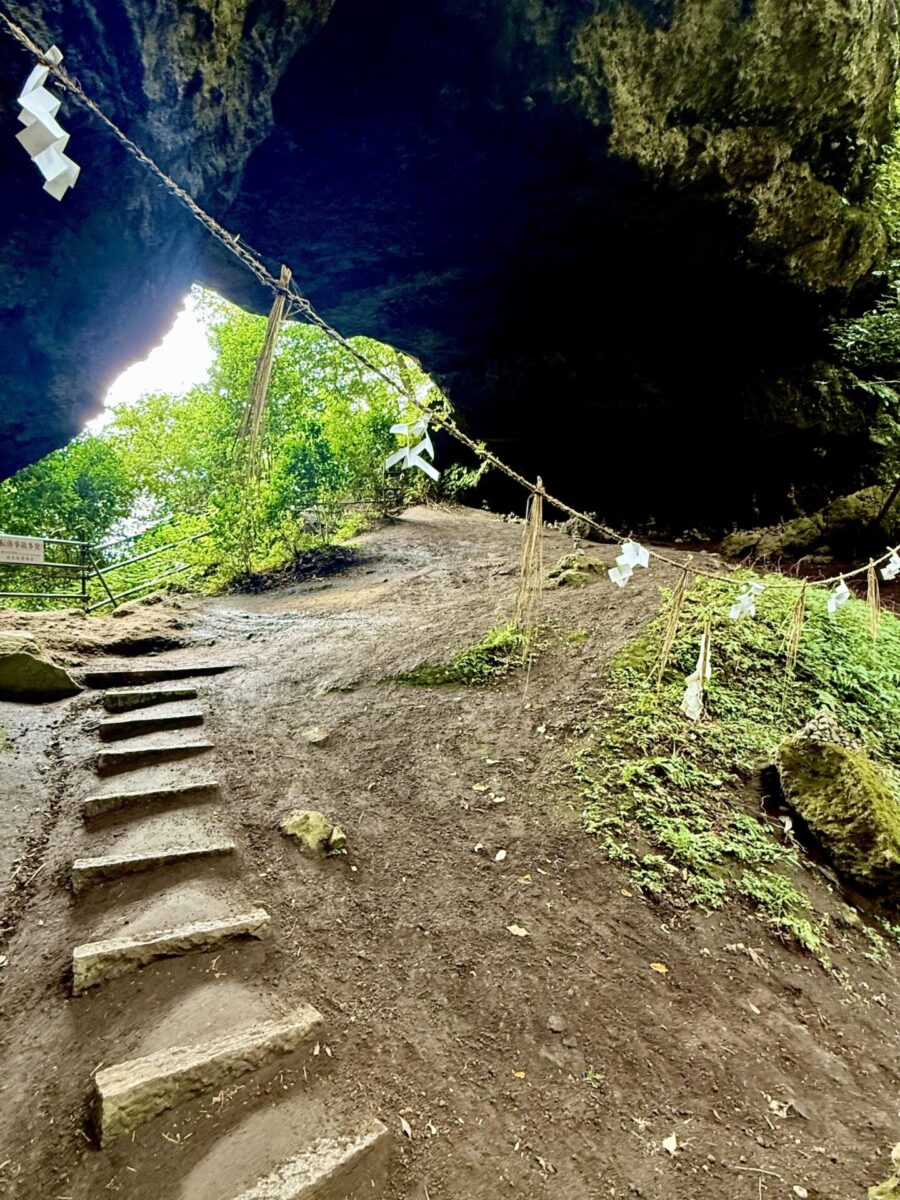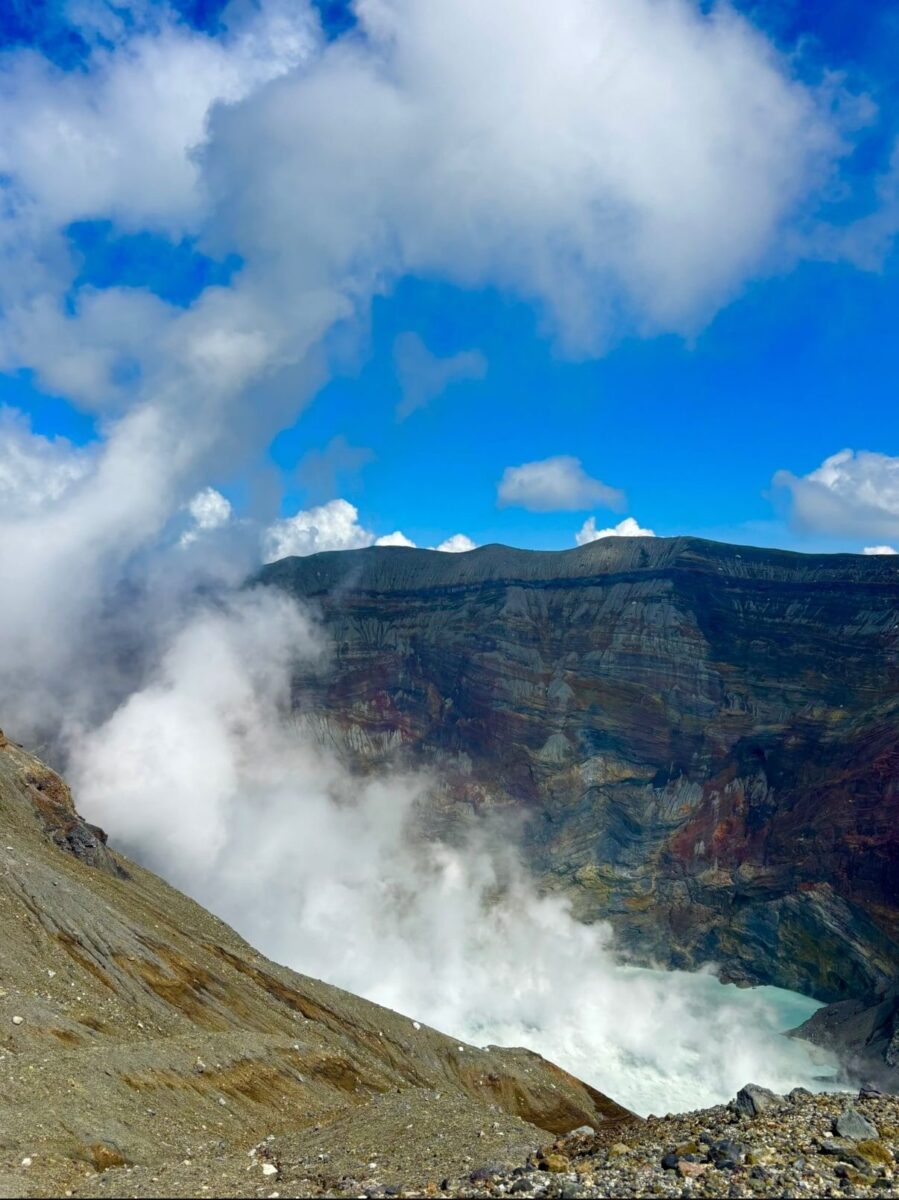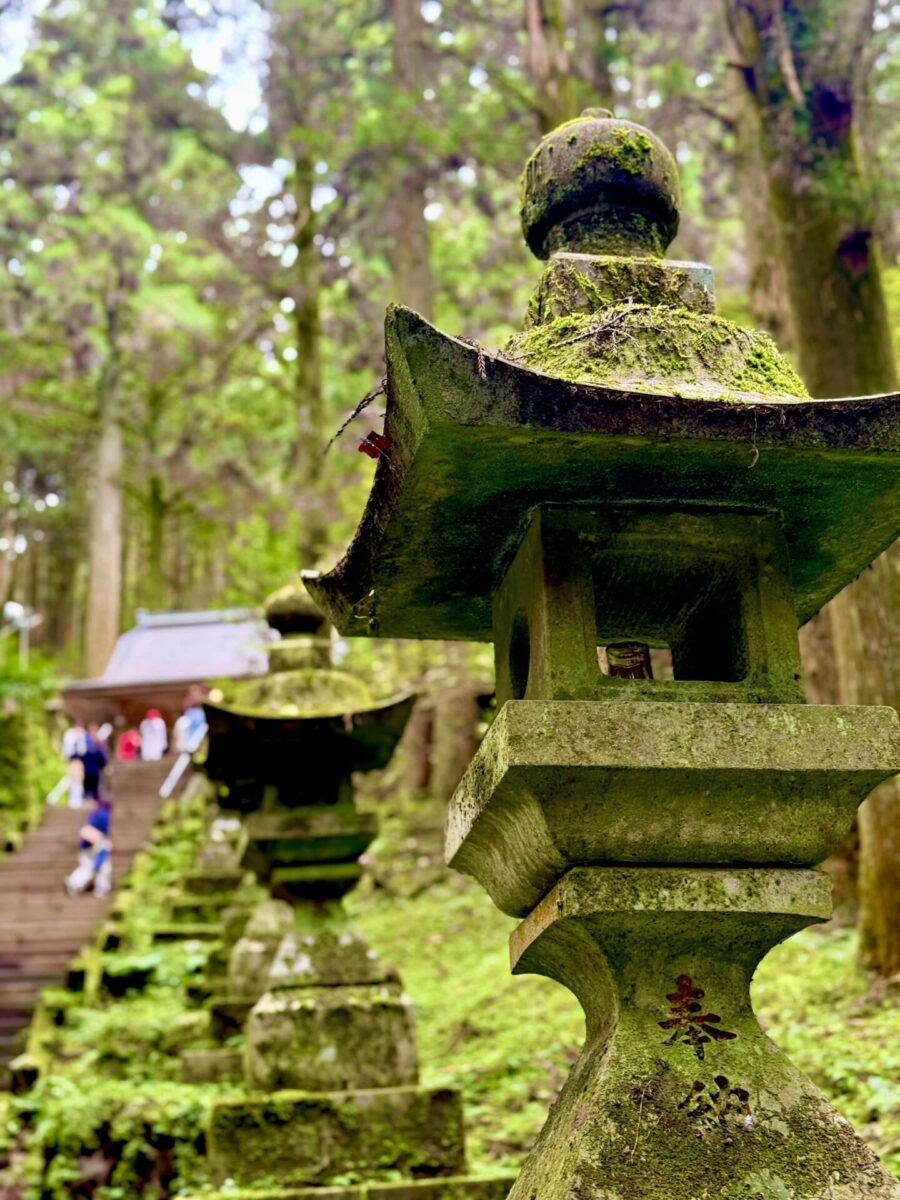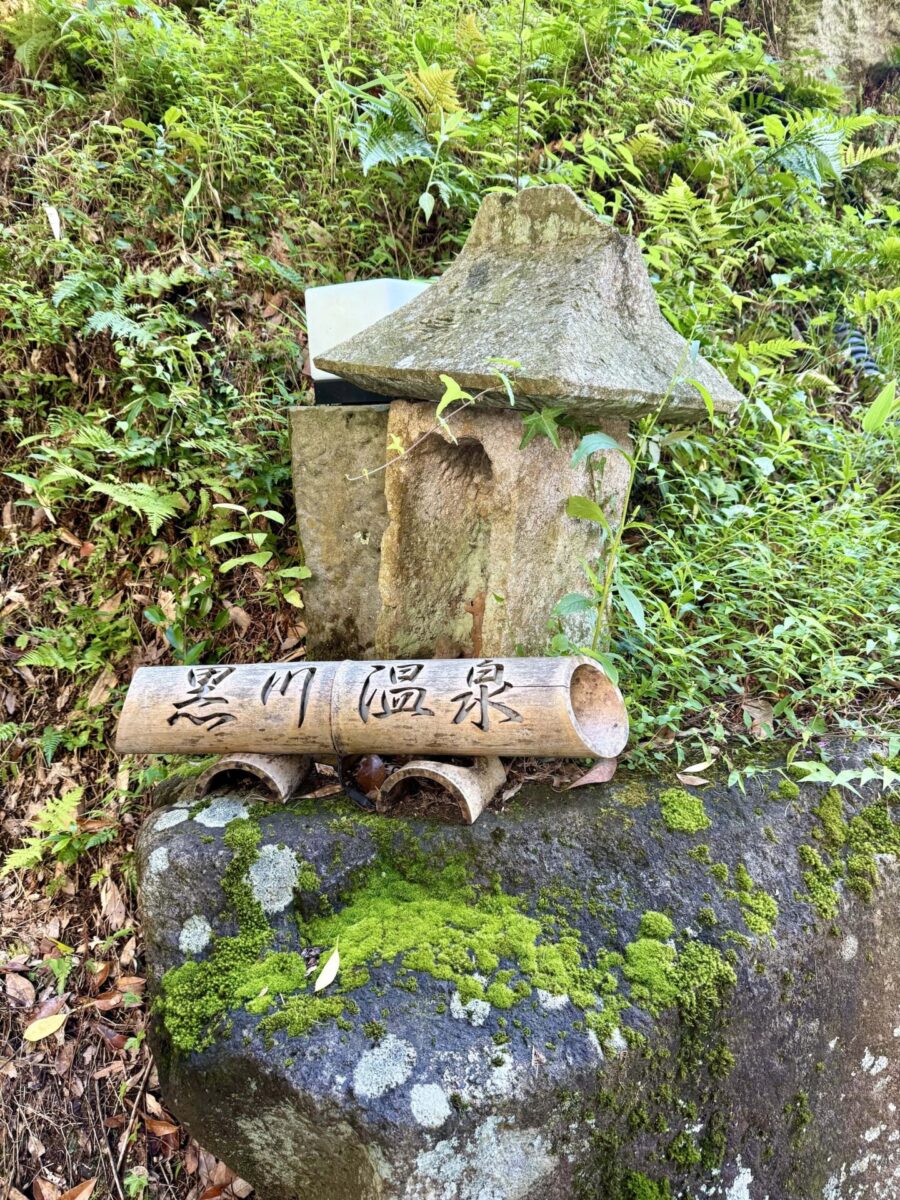
I recently had the pleasure of joining a Get Your Guide guided tour of Kumamoto Prefecture, Japan. This was my first guided tour after 6+ years of living in the country – so I thought I’d share my experience for anyone who’s considering booking one of these tours.
Some links on this page are affiliate links. We may earn a commission if you make a purchase, at no additional cost to you.
As a 1-day tour to 3 destinations, you definitely get the bang for your buck, as the tour is only around $60 USD. Included is the bus fee and the guide explanations, but no food or any tickets for attractions.
Itinerary: Mt. Aso Volcano, Kusasenri & Grasslands Day Tour
The tour started strong at the crater lake on top of Mount Aso, an active volcano, then went on to the nearby “thousand-mile grassland” called Kusasenri, where wild horses roam. Then we passed through the magical forests and age-old shrine that inspired the hit anime “Hotarubi no Mori e”, and finally ended with a soak in the open-air hot springs deep in the mountains of Kurokawa Onsen.
Click here for the full itinerary.
Trip Planning Tips
Airfare deals – find your best deal.
Lodging deals – from capsules to luxury stays.
Guided Tours – customized or pre-made.
Travel Insurance – just in case.
SIMs/eSIMS – data or voice, text, & data. 25% off long-term voice, text, and data
Now—is the tour actually worth it? How was the pacing? What was each spot like? I know you’re dying to find out, so read on for the specifics!
Stop 1: Aso Volcano & Kusasenrigahama:
Where the Earth Breathes

After meeting our tour guide around 7:30 AM and getting on the bus, we set off to Mount Aso, about a 2-hour drive from central Fukuoka.
Mount Aso is an active volcano. It’s generally safe but can be unpredictable, and whether it’s safe to go up to the lip of the crater is decided the morning of the tour by the prefectural government.
On this day, the volcano was fast asleep as we got off the tour bus and took another shuttle bus (separate tickets for 1400 yen round-trip) to the mouth of the volcano.
Unfortunately, this late September day was foggy with light showers, making the already steamy volcano indistinguishable from the mists of the mountain; all I saw was white.
The wind whipped our hair and clothes around wildly, and I was glad we went on a still-warm early autumn day instead of in the dead of winter. According to our guide, the best photo spot for the Aso volcano lies to the right side of the crater after you cross the bridge.

Once there, we saw a brief glimpse of emerald green at the bottom of the crater, where rain collects and mixes with the sulfur and volcanic minerals for that brilliant gem-like color – it would have been stunning on a sunny day. If you have a drone camera, this would be the perfect place for photos—though local drone laws can be strict in Japan, so I would recommend checking them beforehand.
Slightly disappointed but nevertheless hopeful, we make our way down towards the bus to head for our next destination – the Kusasenri grasslands.
This was the part of the trip I was most excited about – after seeing countless reels and TikToks of (seemingly) wild ponies roaming freely in the vast plains of Kusasenri, I desperately wanted to see it for myself, and maybe pet a pony or two.
As we ride the bus down towards the plains, I fervently hoped for the weather to clear up with all 20 fingers and toes crossed.

Just when the plains come in sight, patches of blue also begin to appear—but then our guide Jim roused everyone to go get lunch first. He tells us we’ll have an hour and a half at the cafeteria.
Here’s the caveat —the 1.5 hours is for both lunch AND roaming the grasslands, and a horseback ride if you want one. He didn’t explicitly tell us to rush through our lunch, but my friend and I scarf down our food as fast as humanly possible before departing to the grasslands about a 5-minute walk away.
By this time, the sun was out and shining brightly with nary a raincloud to be seen.
The brilliant green of the plains contrasted against azure skies, and golden reeds swayed gently as fluffy cotton candy clouds were reflected in the pond across the hill from the plains. I actually imagined I might be in heaven – if heaven had dozens of tourists roaming about.
We only had about 30 minutes left on our clock, so we couldn’t explore the whole of the plains as I wanted, but we made our way up the hill so we could gaze out over at the plains and the pond. The trek was easy, though definitely not accessible for those with wheelchairs, and took less than 10 minutes.
At this point, the only horses we saw were the saddled-up horses for horseback rides near the entrance. There was horse chow for sale if you wanted to feed them, and a guided horseback ride (a trot really) was priced at 1500 yen.
Though there was no magical encounter with a wild pony, the beauty of the grasslands still took my breath away and was worth every minute; in fact, I wish I could’ve spent a few more hours there and maybe had a picnic or a nap. I imagine if we had walked around to where there were fewer tourists, we might’ve been treated to a different view entirely.
Stop 2: Kamishikimi-Kumanoza Shrine:
Into Hotarubi no Mori e’s World

After a short bus ride, we arrive at stop 2: the misty forests and mossy stone shrines that inspired the hit anime, “To the Forest of the Firefly Lights”, or Hotarubi no Mori e, a hauntingly beautiful story about a girl and the forest spirit she can never touch.
The forest itself retained much of the same qualities – haunting, ethereal, and humming with a certain sacred life force. Walking up the uneven, weathered stone steps, we passed by one moss-hewn stone lantern after another, breathing the damp, earthy mountain air in and chatting idly.
Halfway up the steps, we stop by the main entrance to the shrine—the famous torii gates that appear on the cover of the anime. It looks almost exactly the same in real life, and the phrase “art imitates life” popped into my mind unbidden.
The shrine gate is a major photo spot, and you’ll likely encounter a few people waiting for their turn to take a picture. Though beautiful with the dappled sunlight filtering through the trees, the shrine and forest were also gorgeous in the mist and light rain; it made the atmosphere of the forest seem that much more sacred.
Continuing up the rest of the steps, we arrive at the main body of the shrine halfway up the small mountain. A simple affair, there was only the wooden shrine body, the omikuji (fortune) box, and the post to tie up your bad fortunes.
Behind the shrine was a dirt path leading to the top of the mountain, about a 10-minute hike. This is where the resemblance to the Firefly Forest ends; if you climb up all the way, you’ll find a natural outcropping of rock with a large hole you can see the sky through. This is rumored to be the power spot where an “oni” (Japanese demon) escaped by kicking the cliff face in, and the hole in the rock is the footprint of the oni.

On the rock face of that boulder lie numerous coins that people have placed there for good luck. Expect to be fairly out of breath by the time you reach the top, but not exhausted.
After we make our way back to the bottom, we stop by the small souvenir shop where they sell shrine stamps and fox masks similar to the one that the forest spirit from the Firefly Forest wears.
All in all, the forest and the shrine felt otherworldly and mystical, almost like a liminal space between worlds. I would’ve loved to spend an hour or two meditating or just soaking in the sounds and life force of the forest.
Be warned— as with most tourist attractions, you’ll be faced with other tourists from all over the world. This is especially true if you’re on a guided tour with a bus full of other tourists — it’s nearly inescapable.
Stop 3: Kurokawa Onsen:
A Cocoon in Time
By the time we reached Kurokawa Onsen, it was just before 3 PM.

Kurokawa is a tiny hot spring town tucked deep in the mountains, and time moved differently there.
Wooden inns lined cobbled stone paths that wind along the river. Steam drifts lazily here and there from hidden baths, and the sounds of the river mingle with the bells of shop doors opening and closing.
Our guide recommended 2 or 3 higaeri, or day onsens you can get into under $10. Unfortunately, as we had only an hour and a half, we could only take a stroll and a brief dip in one of the hot springs without truly enjoying the town’s vivid greenery or the calming baths.
We did find a small bakery with some amazing Jersey cow cream puffs—rich and creamy, with the decadent flavors of vanilla and milk—along the winding paths by the river. But after we had it, we speed walked to “Yusai” hot spring hotel and asked for a day pass, took a quick 15-minute dip in the near-summer temperatures, and trotted back to the bus for the meeting time.
If you visit, remember onsen etiquette: rinse before soaking, don’t splash, and definitely don’t bring your phone in. The locals treat the baths like sacred spaces, not just spas—and once you sit in one in the open air, you’ll understand why.
Also, if you want to enjoy a long soak, I’d forgo walking through the town! Kurokawa Onsen is supposed to be gorgeous in the winter, with otherworldly bamboo lights floating above the river; I definitely want to take another trip there and stay a night in the autumn or winter season.
Lodging Recommendations
- https://takanosho.com/lp/rooms/
Takanosho Hotel near Aso, Kumamoto offers private hot spring baths in each decadent Japanese style room, as well as an extensive dinner buffet. - https://www.yusai.com/en/index.html
Hotel Yusai near Kurokawa Onsen is the one where we had a soak in their onsen. They were clean and modern, with a beautiful lobby and sunny lounge overlooking the forest. - https://www.ikoi-ryokan.com/
Kurokawa Onsen Ikoi Inn is the Japanese style “ryokan” that I was recommended by a local. Boasting 13 different hot spring baths and an “irori”, or a Japanese style sunken hearth, this inn is like taking a step back in time and looks to be worth the visit.
Thoughts on the Journey & Guided Tour
From there, we rested in the 2-hour bus ride back to Hakata station in central Fukuoka, and disbanded around 6:30 PM.
All in all, I would say the trip was excellent for getting you to the sights and extremely affordable for what you get. The only con is how rushed it felt. Of course, different tours are run differently, and another tour that I went on since felt much better paced, but the distance you travel means that you have very little time at each scenic spot to really relax and enjoy. Perhaps 1-2 hours tops at each place, which I imagine some people might not mind!
If I had tried to make this trip myself—going across 2 prefectures and 4 different attractions, renting a car for a day, and covering gas and highway tolls —the cost would EASILY double or triple the tour price. Not to mention – if going by public transportation, the bullet train from Fukuoka to Kumamoto alone would cost 12,000 yen round trip – not to mention the extra time and money you’d spend making train and bus transfers. Out in the countryside of Kyushu, some trains only come once an hour and would take forever to get to your destination. For example, from Kumamoto Station to Kurokawa Onsen would take around 3 hours one way by bus, and Kusasenrigahama would take 2 hours by train.
If you think of it that way, 6600 yen round-trip for transportation and occasional commentary from the guide is VERY worth it. I would recommend this value-pack tour for sure if you don’t have time to stay a night at each place to enjoy them thoroughly.
The End of the Journey
There’s something about this part of Japan that touches you in a way that can’t be put into words. Maybe it’s the way the mist drifts through the trees at Kamishikimi-Kumanoza Shrine, or how the ground hums with life at Kusasenri’s grasslands.
Away from the crowds of Tokyo and Kyoto, it was like getting an injection of the core essence of Japan – surrounded by mossy forests and ancient shrines, idyllic rolling hills and natural hot springs. That’s the type of calm and zen that whisks away your worries and churning thoughts, a reminder that nature is vast and you are tiny.
Despite the rushed pace of the tour and the crowd of other tourists at each destination that came on our bus, it was still a beautiful experience and well worth it. For this tour, I recommend booking with Get Your Guide here.
Check out other Get Your Guide tours of Kyushu here.
If you’re curious about the remarkable waterfall gorges of Takachiho in Miyazaki, check out my upcoming article here!
As for Kumamoto, bring your camera and some sturdy walking shoes, and be prepared to be inspired by nature’s beauty!

Leave a Reply